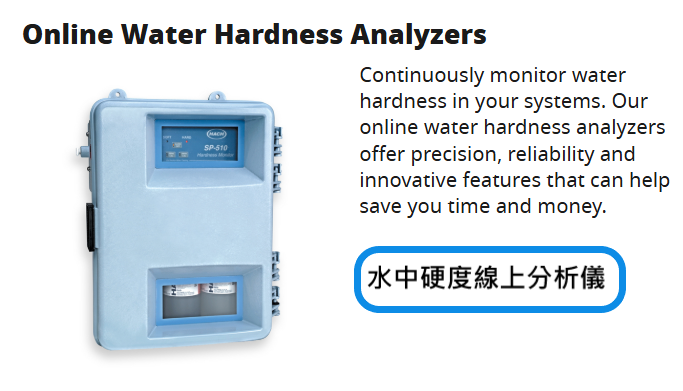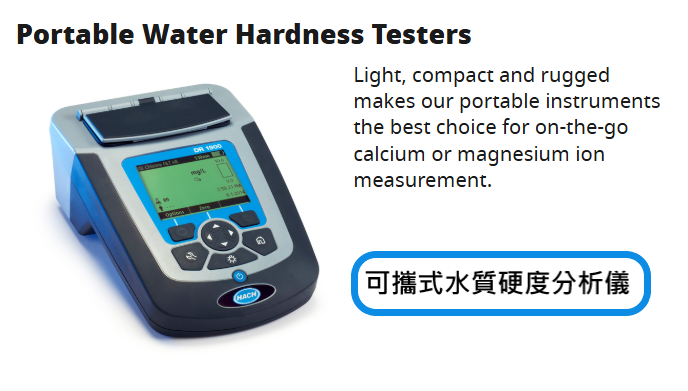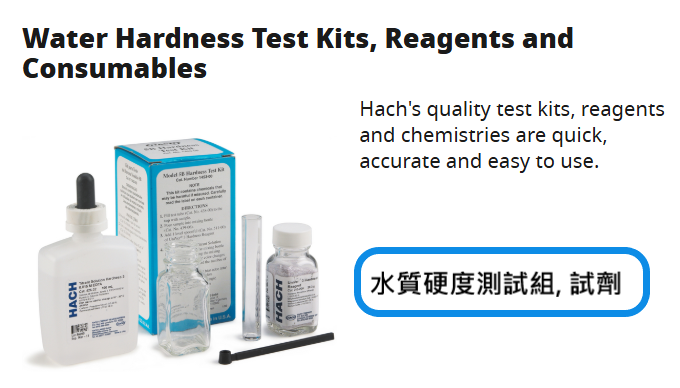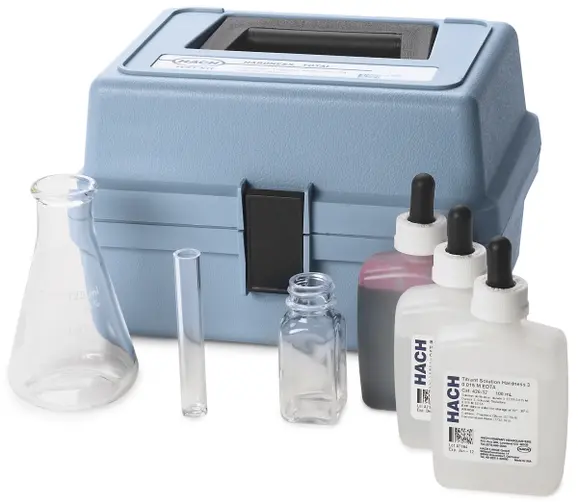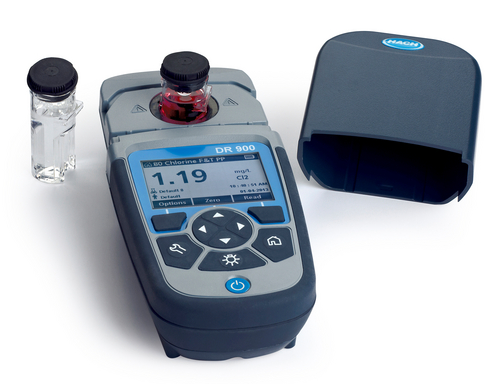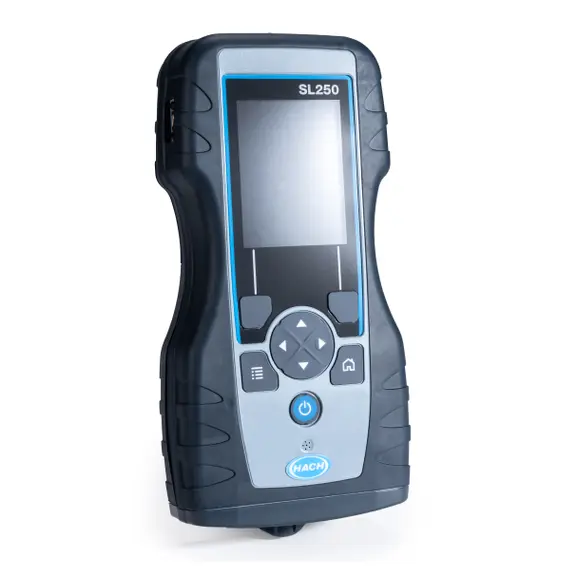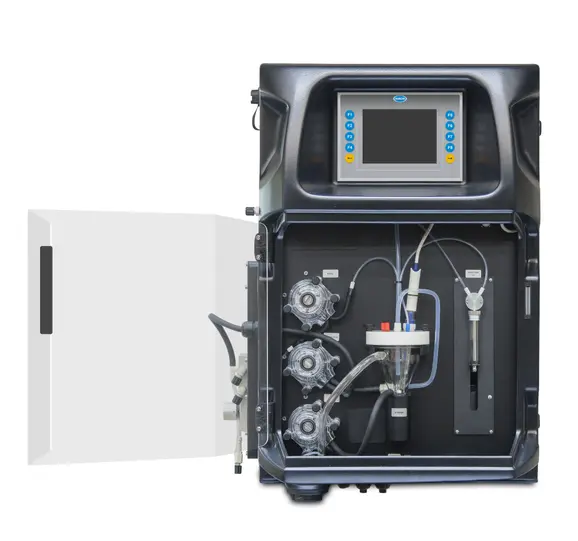水硬度與分析 Hardness (Total, Ca & Mg)

Why Measure Hardness? 為什麼要測量水質硬度?
In general, hard water forms solid deposits comprised of mainly calcium and magnesium salts and can damage equipment, while soft water may be corrosive and therefore, it is important measuring and knowing levels of hardness in your process water to maintain the delicate balance between scaling and corrosivity.
In general, hard water forms solid deposits comprised of mainly calcium and magnesium salts and can damage equipment, while soft water may be corrosive and therefore, it is important measuring and knowing levels of hardness in your process water to maintain the delicate balance between scaling and corrosivity.
While some hardness may be acceptable in certain water quality applications, others require zero hardness to prevent scaling and damage to equipment. Therefore, water softening by either precipitation or ion exchange is often necessary to remove hardness. To optimize these processes, it is sometimes important to monitor calcium and magnesium levels separately, along with total hardness.
Additionally, magnesium can interfere with other water quality tests such as nitrogen, ammonia-salicylate methods. Visit these related parameter pages to learn more about ammonia and nitrogen.
At Hach®, find the testing equipment, resources, training, and software you need to correctly monitor and manage water hardness in your specific application.
一般來說,硬水會形成主要由鈣鹽和鎂鹽組成的固體沉積物,會損壞設備,而軟水可能具有腐蝕性,因此,測量以了解過程用水的硬度濃度非常重要,以保持結垢和腐蝕性之間的微妙平衡。
雖然某些硬度在某些水質應用中可能是可接受的,但其他應用則需要零硬度以防止結垢和損壞設備。因此,通常需要透過沉澱或離子交換來軟化水以去除硬度。為優化這些過程,有時單獨監測鈣和鎂的濃度以及總硬度很重要。
Featured Water Hardness Product Categories Hach水硬度分析儀器與試劑
Which Processes Require Hardness Monitoring? 哪些程序需要水質硬度監測?
Drinking Water Industry 飲用水/自來水
Excessive hardness of finished water released in the distribution system may cause scaling and if the water is too soft, it can cause corrosion of the pipes. Thus, leaching out lead and copper which may lead to violation of the lead and copper rule (LCR). 配水系統中釋放的完成水如果硬度過高可能會導致結垢; 而如果水太軟,則會導致管道腐蝕。因此,浸出鉛和銅可能會導致違反鉛和銅的法規標準 (LCR)。
Excessive hardness of finished water released in the distribution system may cause scaling and if the water is too soft, it can cause corrosion of the pipes. Thus, leaching out lead and copper which may lead to violation of the lead and copper rule (LCR). 配水系統中釋放的完成水如果硬度過高可能會導致結垢; 而如果水太軟,則會導致管道腐蝕。因此,浸出鉛和銅可能會導致違反鉛和銅的法規標準 (LCR)。
Wastewater 廢污水
During sludge digestion, monitor hardness to optimize efficiency. Soap biodegradation and oxygen uptake by activated sludge are affected by elevated hardness concentrations. 在污泥消化過程中,監測硬度以優化效率。
During sludge digestion, monitor hardness to optimize efficiency. Soap biodegradation and oxygen uptake by activated sludge are affected by elevated hardness concentrations. 在污泥消化過程中,監測硬度以優化效率。
Pool and Spa Water Testing 泳池和SPA水質
Water that is too "hard" can cause scaling, deposits of calcium carbonate. "Soft water" will corrode pipes and surfaces inside the pool, which contain calcium (like pool plaster) and other minerals. 太“硬”的水會導致水垢和碳酸鈣沉積。 「軟水」會腐蝕泳池內的管道和表面。
Water that is too "hard" can cause scaling, deposits of calcium carbonate. "Soft water" will corrode pipes and surfaces inside the pool, which contain calcium (like pool plaster) and other minerals. 太“硬”的水會導致水垢和碳酸鈣沉積。 「軟水」會腐蝕泳池內的管道和表面。
Power Industry 電力能源產業
Water hardness can cause scaling in water heaters and boiler tubes. Therefore, it is crucial to monitor and remove all salts, especially those causing hardness. 水的硬度會導致熱水器和鍋爐管道結垢。因此,監測和去除所有鹽分是關鍵,特別是造成硬度的鹽分。
Water hardness can cause scaling in water heaters and boiler tubes. Therefore, it is crucial to monitor and remove all salts, especially those causing hardness. 水的硬度會導致熱水器和鍋爐管道結垢。因此,監測和去除所有鹽分是關鍵,特別是造成硬度的鹽分。
Chemical Manufacturing Industry 化學製造產業
Monitor incoming water for mineral content in order to properly adjust product water quality and sensory factors. Monitor the performance of water softening systems to avoid scaling and assess the load on reverse osmosis systems. Continuous monitoring of boiler/cooling water (leaving the condenser) helps to detect minute and fluctuating levels of hardness that can cause scaling in piping, condensers and dryers over time. This allows operators to manage hardness levels, preventing damage and lost revenue due to downtime. 監測進水中的礦物質含量,以便適當調整水質和感官因素。監測軟化水系統的效能以避免結垢並評估逆滲透系統的負荷量。持續監測鍋爐/冷卻水(離開冷凝器)有助於檢測微小且波動的硬度值,硬度可能會隨著時間導致管道、冷凝器和乾燥器結垢。操作人員得以準越管理硬度值,防止停機而造成損壞和收入損失。
Monitor incoming water for mineral content in order to properly adjust product water quality and sensory factors. Monitor the performance of water softening systems to avoid scaling and assess the load on reverse osmosis systems. Continuous monitoring of boiler/cooling water (leaving the condenser) helps to detect minute and fluctuating levels of hardness that can cause scaling in piping, condensers and dryers over time. This allows operators to manage hardness levels, preventing damage and lost revenue due to downtime. 監測進水中的礦物質含量,以便適當調整水質和感官因素。監測軟化水系統的效能以避免結垢並評估逆滲透系統的負荷量。持續監測鍋爐/冷卻水(離開冷凝器)有助於檢測微小且波動的硬度值,硬度可能會隨著時間導致管道、冷凝器和乾燥器結垢。操作人員得以準越管理硬度值,防止停機而造成損壞和收入損失。
Food Manufacturing Industry 食品製造產業
Monitor and manage total hardness to optimize boiler and cooling tower feed water. This minimizes chemical usage, prevents corrosion/scaling and protects plant equipment. 監測和管理水中總硬度以優化鍋爐和冷卻水塔給水。有助於將化學品的使用量最小化,防止腐蝕/結垢並保護廠區設備。
Monitor and manage total hardness to optimize boiler and cooling tower feed water. This minimizes chemical usage, prevents corrosion/scaling and protects plant equipment. 監測和管理水中總硬度以優化鍋爐和冷卻水塔給水。有助於將化學品的使用量最小化,防止腐蝕/結垢並保護廠區設備。
Mining Industry 採礦產業
Water is essential to metal and mining operations, but the industry is seldom the only consumer of water near extraction or processing sites. By monitoring and treating source water, mining companies not only ensure their own quality standards are met, but they also can contribute to the health of communities, agricultural resources and wildlife ecosystems in the process. Whether obtained from groundwater or precipitation, oceans or lakes, rivers or streams, through commercial or municipal supply—the water utilized in mining is interconnected with the water cycle of the entire region.
Water is essential to metal and mining operations, but the industry is seldom the only consumer of water near extraction or processing sites. By monitoring and treating source water, mining companies not only ensure their own quality standards are met, but they also can contribute to the health of communities, agricultural resources and wildlife ecosystems in the process. Whether obtained from groundwater or precipitation, oceans or lakes, rivers or streams, through commercial or municipal supply—the water utilized in mining is interconnected with the water cycle of the entire region.
Pulp and Paper Industry 紙漿和造紙產業
Monitor total hardness in water supplies to guard against in-plant corrosion and/or scaling, as well as effects of high hardness on the product quality. 監測供水中的總硬度,以防止內部腐蝕和/或結垢,以及高硬度水質對產品品質的影響。
Monitor total hardness in water supplies to guard against in-plant corrosion and/or scaling, as well as effects of high hardness on the product quality. 監測供水中的總硬度,以防止內部腐蝕和/或結垢,以及高硬度水質對產品品質的影響。
Beverage Industry 飲料產業
Hardness of the water used to make beverages may affect their organoleptic properties. 用於製作飲料的水的硬度可能會影響其飲料的感官特色。
Hardness of the water used to make beverages may affect their organoleptic properties. 用於製作飲料的水的硬度可能會影響其飲料的感官特色。
How is Water Hardness Measured? 水質硬度如何量測?
Titration 滴定法
Hardness is commonly measured by colorimetric titration with an EDTA solution. A titration involves adding indicator and then titrant solution in small increments to a water sample until the sample changes color. You can titrate a sample for total hardness using a burette or use a water hardness test kit. You can also measure calcium hardness separately from magnesium hardness by adjusting the pH and using different indicators.
Hardness is commonly measured by colorimetric titration with an EDTA solution. A titration involves adding indicator and then titrant solution in small increments to a water sample until the sample changes color. You can titrate a sample for total hardness using a burette or use a water hardness test kit. You can also measure calcium hardness separately from magnesium hardness by adjusting the pH and using different indicators.
水質硬度通常用 EDTA 溶液以比色滴定法來測量。滴定包括向水樣以小增量添加指示劑和滴定劑溶液,直到樣品改變顏色。您可以使用滴定管滴定樣品的總硬度,或使用水硬度測試套組。您也可以透過調節 pH 值和使用不同的指示劑來分別測量鈣硬度和鎂硬度。
Drop Count Test Kits
This hardness test uses a dropper to add the EDTA solution to the sample and the drop counts are proportional to the water hardness. Total hardness test kit model HA-71A, uses ManVer® indicator and works best for natural water samples, especially when iron or manganese is present, or when alkalinity is high. Test kit models 5-B, 5-EP, and 5-EP/MG-L, which use UniVer® reagent, work best for industrial samples that may have high concentrations of metals, such as copper. Other test kits are available for measuring calcium and magnesium hardness separately. 此硬度測試使用滴管將 EDTA 溶液加到水樣中,滴數與水的硬度成正比。總硬度測試套組 Total Hardness Test Kit, Model HA-71A,使用 ManVer® 指示劑,最適合用於天然水樣,特別是當含有鐵或錳時,或當鹼度較高時。使用 UniVer® 試劑的測試套組型號 總硬度測試組 Total Hardness Test Kit, Model 5-B 、5-EP 和 5-EP/MG-L 最適合可能含有高濃度金屬(例如銅)的工業水樣。還有其他測試套組可用於分別測量鈣和鎂的硬度。
This hardness test uses a dropper to add the EDTA solution to the sample and the drop counts are proportional to the water hardness. Total hardness test kit model HA-71A, uses ManVer® indicator and works best for natural water samples, especially when iron or manganese is present, or when alkalinity is high. Test kit models 5-B, 5-EP, and 5-EP/MG-L, which use UniVer® reagent, work best for industrial samples that may have high concentrations of metals, such as copper. Other test kits are available for measuring calcium and magnesium hardness separately. 此硬度測試使用滴管將 EDTA 溶液加到水樣中,滴數與水的硬度成正比。總硬度測試套組 Total Hardness Test Kit, Model HA-71A,使用 ManVer® 指示劑,最適合用於天然水樣,特別是當含有鐵或錳時,或當鹼度較高時。使用 UniVer® 試劑的測試套組型號 總硬度測試組 Total Hardness Test Kit, Model 5-B 、5-EP 和 5-EP/MG-L 最適合可能含有高濃度金屬(例如銅)的工業水樣。還有其他測試套組可用於分別測量鈣和鎂的硬度。
Digital Titrator
Kits using the digital titrator can measure hardness more accurately than drop count titration kits. This is because the digital titrator dispenses the EDTA solution in very small increments with higher precision. Hardness test kits with digital titrator use the ManVer® indicator. 使用數位滴定儀的套組可以比滴數滴定套組更準確地測量水質硬度。這是因為數位滴定儀以非常小的增加量分配 EDTA 溶液,並且準確度更高。附數位滴定儀的硬度測試套組使用 ManVer® 指示器。
Kits using the digital titrator can measure hardness more accurately than drop count titration kits. This is because the digital titrator dispenses the EDTA solution in very small increments with higher precision. Hardness test kits with digital titrator use the ManVer® indicator. 使用數位滴定儀的套組可以比滴數滴定套組更準確地測量水質硬度。這是因為數位滴定儀以非常小的增加量分配 EDTA 溶液,並且準確度更高。附數位滴定儀的硬度測試套組使用 ManVer® 指示器。
Test Strips
When the water hardness test strip is dipped in a water sample, a color develops on the strip and the strip is matched to a chart. The chart shows colors for concentrations of 0, 25, 50, 120, 250, and 425 ppm, or 1, 1.5, 3.7, 15, and 25 gpg. Use the test strips when a general range for hardness is sufficient. Test strips should not be used when an exact hardness value is required. 當將水硬度試紙浸入水樣中時,試紙上會顯現出顏色,並且試紙與圖表相符。圖表顯示濃度為 0、25、50、120、250 和 425 ppm 或 1、1.5、3.7、15 和 25 gpg 的顏色。當硬度的一般範圍足夠時,使用測試條。當需要精確的硬度值時,不應使用試紙。
When the water hardness test strip is dipped in a water sample, a color develops on the strip and the strip is matched to a chart. The chart shows colors for concentrations of 0, 25, 50, 120, 250, and 425 ppm, or 1, 1.5, 3.7, 15, and 25 gpg. Use the test strips when a general range for hardness is sufficient. Test strips should not be used when an exact hardness value is required. 當將水硬度試紙浸入水樣中時,試紙上會顯現出顏色,並且試紙與圖表相符。圖表顯示濃度為 0、25、50、120、250 和 425 ppm 或 1、1.5、3.7、15 和 25 gpg 的顏色。當硬度的一般範圍足夠時,使用測試條。當需要精確的硬度值時,不應使用試紙。
Colorimetry or Spectrophotometry 比色法或分光光度法
Use a colorimeter or a spectrophotometer when you need to measure hardness of extremely soft water, where the concentration is expected to be less than 4 mg/L as CaCO3 (calmagite method). 當您需要測量極軟水的硬度時,請使用比色計或分光光度計,其濃度預計低於 4 mg/L(以 CaCO3 計)(鈣鎂磷礦法)。
Use a colorimeter or a spectrophotometer when you need to measure hardness of extremely soft water, where the concentration is expected to be less than 4 mg/L as CaCO3 (calmagite method). 當您需要測量極軟水的硬度時,請使用比色計或分光光度計,其濃度預計低於 4 mg/L(以 CaCO3 計)(鈣鎂磷礦法)。
Use a spectrophotometer when you need to measure ultra-low hardness in water, where the concentration is expected to be less than 1 mg/L as CaCO3 (chlorophosphonazo method). 當您需要測量水中的超低硬度時,請使用分光光度計,其中預計濃度低於 1 mg/L(以 CaCO3 計)(偶氮氯膦法)。
Use a spectrophotometer to measure higher ranges of total, Ca and Mg hardness. 使用分光光度計測量更高濃度範圍的總硬度、鈣硬度和鎂硬度。
Ion-Selective Electrodes 離子選擇電極(探頭)
Calcium can also be measured using an ion-selective electrode, such as the Radiometer ISE25Ca or the 9660C Calcium Ion Selective Electrode (ISE). An electrode is the best method to use when color or turbidity in the sample interferes with colorimetric titration or spectrophotometric methods. 也可以使用離子選擇電極測量鈣,例如 Radiometer ISE25Ca 或 9660C 鈣離子選擇電極 (ISE)。當水樣的顏色或濁度干擾比色滴定或分光光度法時,電極是最佳方法。
Calcium can also be measured using an ion-selective electrode, such as the Radiometer ISE25Ca or the 9660C Calcium Ion Selective Electrode (ISE). An electrode is the best method to use when color or turbidity in the sample interferes with colorimetric titration or spectrophotometric methods. 也可以使用離子選擇電極測量鈣,例如 Radiometer ISE25Ca 或 9660C 鈣離子選擇電極 (ISE)。當水樣的顏色或濁度干擾比色滴定或分光光度法時,電極是最佳方法。
Online Analysis 線上分析
Online analyzers allow for continuous hardness monitoring. These instruments can activate alarms or control chemical feed pumps when the hardness concentration reaches a selected level. 線上分析儀可以持續監測水中硬度。當硬度濃度達到選定的濃度時,水中硬度線上分析儀器可以啟動警示或控制化學進料泵。
Online analyzers allow for continuous hardness monitoring. These instruments can activate alarms or control chemical feed pumps when the hardness concentration reaches a selected level. 線上分析儀可以持續監測水中硬度。當硬度濃度達到選定的濃度時,水中硬度線上分析儀器可以啟動警示或控制化學進料泵。
Water Softening 水質軟化
To reduce undesirable hardness, water must be softened. Softening methods typically fall into two main categories: 為降低不良硬度,必須將水軟化。軟化方法通常分為兩大類:
To reduce undesirable hardness, water must be softened. Softening methods typically fall into two main categories: 為降低不良硬度,必須將水軟化。軟化方法通常分為兩大類:
Ion Exchange Softening Process 離子交換軟化程序
This process exchanges cations causing hardness with non-hardness-causing cations, typically sodium, using either natural or synthetic ion-exchanging matrix, e.g. resin. For example, naturally occurring matrices include greensands and zeolites. Different ion-exchange resins (or matrices) possess varying properties. Synthetic materials tend to have a higher exchange capacity, so they are better for removing higher levels of hardness. Resins using hydrogen as the cation are commonly referred to as demineralizers and usually are comprised of both cation and anion-exchange resins to maintain neutral pH. For health reasons, it is important to note that sodium-based resin will increase the sodium levels in the treated water. This may also provide interference to some ULR hardness methods. 此程序使用天然或合成的離子交換基質將導致水硬度的陽離子與不導致硬度的陽離子(通常是鈉)進行交換,例如樹脂。例如,天然存在的基質包括綠砂和沸石。不同的離子交換樹脂(或基質)具有不同的特性。合成材料往往具有更高的交換容量,因此更適合去除更高硬度的材料。使用氫作為陽離子的樹脂通常被稱為脫鹽劑,通常由陽離子和陰離子交換樹脂組成,以維持中性 pH 值。基於健康因素,值得注意的是鈉基樹脂會增加處理水中的鈉含量。這也可能對一些超低濃度硬度法產生干擾。
This process exchanges cations causing hardness with non-hardness-causing cations, typically sodium, using either natural or synthetic ion-exchanging matrix, e.g. resin. For example, naturally occurring matrices include greensands and zeolites. Different ion-exchange resins (or matrices) possess varying properties. Synthetic materials tend to have a higher exchange capacity, so they are better for removing higher levels of hardness. Resins using hydrogen as the cation are commonly referred to as demineralizers and usually are comprised of both cation and anion-exchange resins to maintain neutral pH. For health reasons, it is important to note that sodium-based resin will increase the sodium levels in the treated water. This may also provide interference to some ULR hardness methods. 此程序使用天然或合成的離子交換基質將導致水硬度的陽離子與不導致硬度的陽離子(通常是鈉)進行交換,例如樹脂。例如,天然存在的基質包括綠砂和沸石。不同的離子交換樹脂(或基質)具有不同的特性。合成材料往往具有更高的交換容量,因此更適合去除更高硬度的材料。使用氫作為陽離子的樹脂通常被稱為脫鹽劑,通常由陽離子和陰離子交換樹脂組成,以維持中性 pH 值。基於健康因素,值得注意的是鈉基樹脂會增加處理水中的鈉含量。這也可能對一些超低濃度硬度法產生干擾。
Once the exchange capacity of a resin has been exhausted, most can be regenerated so it is important to monitor effluent hardness to determine when the column needs regeneration. In this two-step process, first the unit is flushed to remove sediment, and then a brine solution is circulated through the resin at certain conditions to replace the accumulated calcium and magnesium ions with the cation used for softening originally. 一旦樹脂的交換容量耗盡,大多數都可以再生,因此監測排放水的硬度值非常重要。在這個兩步驟過程中,首先沖洗裝置以去除沉積物,然後在一定條件下將鹽水溶液循環通過樹脂,以最初用於軟化的陽離子取代累積的鈣和鎂離子。
Advantages
- The method does not appreciably affect other properties of the water, such as pH.
- Hardness causing cations other than magnesium and calcium are also removed by this process.
- This process can reduce hardness to near zero.
Disadvantages
- High levels of iron or manganese in the water can foul the ion exchange resin.
- Sodium resins can elevate sodium levels in finished water and cause interference to some ULR methods for hardness monitoring.
- High solids can foul resin beds, causing additional expense.
Precipitation Softening Process 沉澱軟化程序
Precipitation is typically accomplished with the lime-soda process. When lime is added to hard water, it causes a reaction with the carbonate hardness present producing solids that then must be removed from the water. Lime and soda ash can be used together to remove both carbonate and non-carbonate hardness. Compared with calcium precipitation, magnesium precipitation requires twice the amount of chemical additive and generates twice the amount of sludge that must be removed. Excess carbon dioxide must be removed prior to softening because it can impede lime precipitation. 沉澱通常以石灰蘇打程序進行。當將石灰加到硬水中時,它會與其中的碳酸鹽硬度發生反應,產生必須從水中去除的固體。石灰和蘇打灰可以一起使用來去除碳酸鹽和非碳酸鹽硬度。與鈣沉澱相比,鎂沉澱需要兩倍的化學添加劑,並且產生兩倍的需要去除的污泥。軟化前必須除去多餘的二氧化碳,因為它會阻礙石灰沉澱。
Precipitation is typically accomplished with the lime-soda process. When lime is added to hard water, it causes a reaction with the carbonate hardness present producing solids that then must be removed from the water. Lime and soda ash can be used together to remove both carbonate and non-carbonate hardness. Compared with calcium precipitation, magnesium precipitation requires twice the amount of chemical additive and generates twice the amount of sludge that must be removed. Excess carbon dioxide must be removed prior to softening because it can impede lime precipitation. 沉澱通常以石灰蘇打程序進行。當將石灰加到硬水中時,它會與其中的碳酸鹽硬度發生反應,產生必須從水中去除的固體。石灰和蘇打灰可以一起使用來去除碳酸鹽和非碳酸鹽硬度。與鈣沉澱相比,鎂沉澱需要兩倍的化學添加劑,並且產生兩倍的需要去除的污泥。軟化前必須除去多餘的二氧化碳,因為它會阻礙石灰沉澱。
Advantages
- This process may remove excess iron and fluoride.
- Due to the high pH, bacteria and viruses may be removed by this process.
- With proper control, corrosivity and scale formation can be controlled with this method.
Disadvantages
- It produces a considerable amount of sludge that requires disposal.
- Operation and chemical costs are high.
- The addition of soda ash may affect sodium levels in the water.
- Recarbonation, or the reintroduction of carbon dioxide, must be performed after softening to lower pH, to remove excess lime and to encourage the precipitation of any remaining calcium carbonate.
- This process cannot reduce hardness to zero.
- This process requires a high degree of operator skills to control

